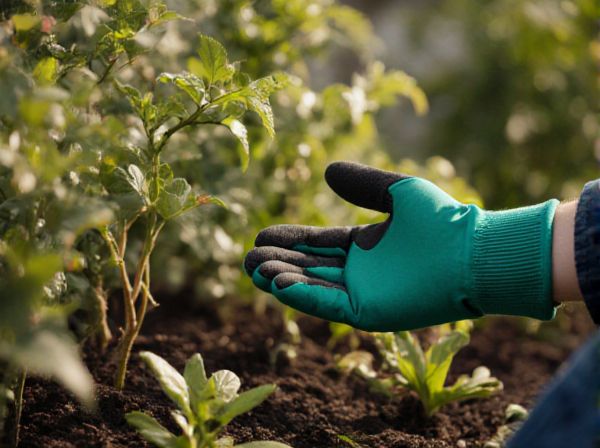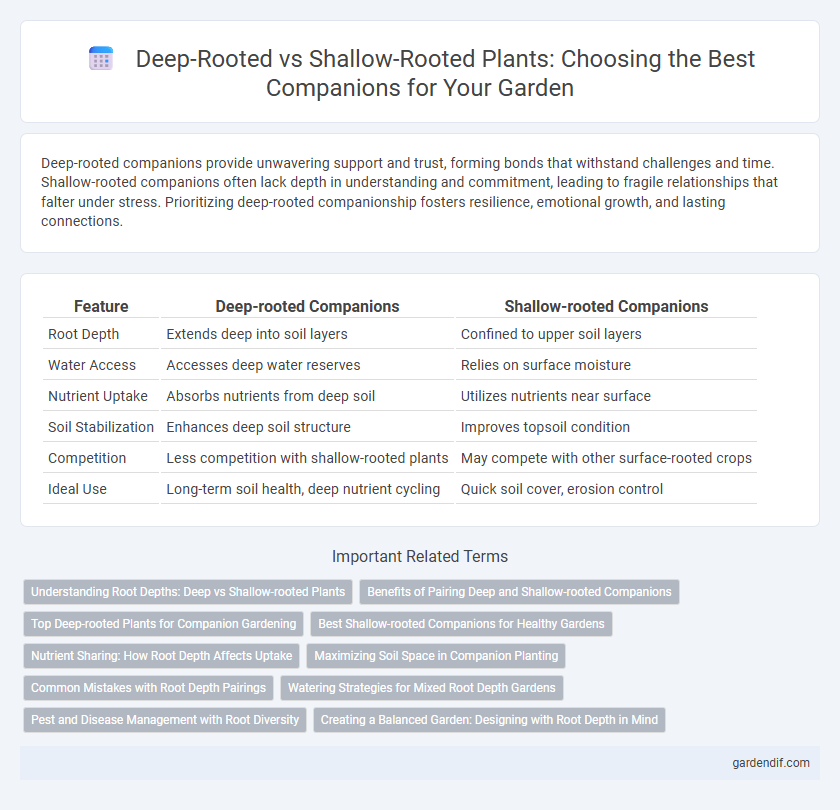
Deep-rooted companions vs shallow-rooted companions Illustration
Deep-rooted companions provide unwavering support and trust, forming bonds that withstand challenges and time. Shallow-rooted companions often lack depth in understanding and commitment, leading to fragile relationships that falter under stress. Prioritizing deep-rooted companionship fosters resilience, emotional growth, and lasting connections.
Table of Comparison
| Feature | Deep-rooted Companions | Shallow-rooted Companions |
|---|---|---|
| Root Depth | Extends deep into soil layers | Confined to upper soil layers |
| Water Access | Accesses deep water reserves | Relies on surface moisture |
| Nutrient Uptake | Absorbs nutrients from deep soil | Utilizes nutrients near surface |
| Soil Stabilization | Enhances deep soil structure | Improves topsoil condition |
| Competition | Less competition with shallow-rooted plants | May compete with other surface-rooted crops |
| Ideal Use | Long-term soil health, deep nutrient cycling | Quick soil cover, erosion control |
Understanding Root Depths: Deep vs Shallow-rooted Plants
Deep-rooted companions penetrate far into the soil, accessing water and nutrients from deeper layers, which enhances drought resistance and soil stability. Shallow-rooted companions absorb moisture and nutrients from the upper soil layers, promoting quick growth and surface nutrient cycling. Understanding root depth differences helps optimize garden planning by pairing plants that maximize resource use and minimize competition.
Benefits of Pairing Deep and Shallow-rooted Companions
Pairing deep-rooted companions with shallow-rooted plants enhances soil utilization by accessing nutrients and moisture at varying depths, reducing competition and improving overall plant health. This symbiotic relationship promotes biodiversity, stabilizes soil structure, and increases resilience to environmental stressors. Combining different root depths optimizes resource use, leading to higher yields and healthier ecosystems in companion planting systems.
Top Deep-rooted Plants for Companion Gardening
Top deep-rooted plants for companion gardening include comfrey, chicory, and daikon radish, each enhancing soil structure and nutrient availability by drawing nutrients from lower soil layers. Comfrey accumulates potassium and calcium, enriching nearby plants, while chicory promotes soil aeration through its extensive taproots. Daikon radish breaks up compacted soil, improving water infiltration and root penetration for neighboring crops.
Best Shallow-rooted Companions for Healthy Gardens
Shallow-rooted companions such as marigolds, basil, and alyssum promote healthy gardens by improving soil aeration and enhancing nutrient uptake without competing deeply with nearby plants. These companions help deter pests like nematodes and aphids, creating a natural pest control system that minimizes the need for chemicals. Integrating shallow-rooted companions supports vigorous growth in vegetable beds and flower gardens by maintaining balanced moisture levels and preventing soil erosion.
Nutrient Sharing: How Root Depth Affects Uptake
Deep-rooted companions access nutrients from deeper soil layers, enhancing overall nutrient uptake compared to shallow-rooted counterparts limited to surface nutrients. This vertical root stratification allows complementary nutrient acquisition, reducing competition and promoting healthier plant growth. By sharing resources efficiently, deep-rooted companions contribute to improved soil nutrient cycling and increased crop resilience.
Maximizing Soil Space in Companion Planting
Deep-rooted companions enhance maximizing soil space in companion planting by accessing nutrients and moisture from deeper soil layers, reducing competition with shallow-rooted plants. Shallow-rooted companions thrive in upper soil layers, efficiently utilizing surface nutrients and improving aeration while complementing their deep-rooted partners. This root stratification optimizes soil resource use, promotes healthier plant growth, and increases overall yield in diverse garden ecosystems.
Common Mistakes with Root Depth Pairings
Choosing deep-rooted companions with shallow-rooted plants often results in competing for surface water and nutrients, leading to stunted growth and poor yield. A common mistake is pairing species with similar root depths, which intensifies resource competition and weakens both plants. Optimal companion planting requires matching deep-rooted species like comfrey with shallow-rooted vegetables such as lettuce to maximize soil resource utilization and improve plant health.
Watering Strategies for Mixed Root Depth Gardens
Deep-rooted companions benefit from infrequent, deep watering that encourages roots to penetrate lower soil layers, enhancing drought resilience and nutrient uptake. Shallow-rooted companions thrive with frequent, light watering to maintain moisture in upper soil layers, preventing stress and promoting surface root health. Implementing stratified watering schedules tailored to mixed root depths optimizes water efficiency and supports diverse plant growth.
Pest and Disease Management with Root Diversity
Deep-rooted companions enhance pest and disease management by promoting root diversity, which improves soil structure and suppresses harmful pathogens through increased microbial activity. These plants penetrate deeper soil layers, accessing nutrients and water unavailable to shallow-rooted species, creating a complementary environment that reduces pest proliferation. Incorporating a mix of deep and shallow-rooted companions fosters a resilient ecosystem that naturally mitigates pest and disease outbreaks while supporting overall plant health.
Creating a Balanced Garden: Designing with Root Depth in Mind
Designing a balanced garden requires understanding the impact of root depth on plant health and growth dynamics. Deep-rooted companions improve soil structure and water access, promoting long-term stability, while shallow-rooted companions enhance surface nutrient utilization and diversity. Integrating both types confers resilience and maximizes resource efficiency, leading to a thriving, sustainable garden ecosystem.
Deep-rooted companions vs shallow-rooted companions Infographic

 gardendif.com
gardendif.com